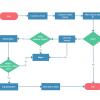Design & Code
Articles
 |
Find Your Metaphor for Agile Software Design How you think about software design can have a big impact on how effective you are when you do it. All of us have different criteria for success, and some of them aren’t even conscious. We have to figure out what resonates for us so that we make the right choices, and we can get a clue about the right choices for us by looking at the metaphors we use when we talk about software. |
|
 |
The Value of Test-Driven Development when Writing Changeable Code Writing changeable code makes it easier and more cost-effective to add features to existing software. Writing changeable code doesn’t take longer, but it does require paying attention to certain things when building a system. It's important to have a good suite of unit tests that support refactoring code when needed, and test-driven development helps you create independently testable code. |
|
 |
DevSecOps: Incorporate Security into DevOps to Reduce Software Risk DevSecOps is a growing movement to incorporate security into DevOps practices in order to ensure flaws and weaknesses are exposed early on through monitoring, assessment, and analysis, so remediation can be implemented far earlier than traditional efforts. By failing fast with security testing, organizations reduce risk of a security incident and decrease the cost of rework. |
|
 |
Fitting Technical Writing into Agile Development As teams strive to move to a mature agile process, technical writers must adapt as effectively as the development personnel. This new agile process demands that knowledge dealing with software or product releases is only sparingly documented up front, making the technical writer's job of gathering information much more dependent on talking with people over reading requirements. |
|
 |
Document Why as Well as What: Finding the Purpose of Your Software Code can express what we want to accomplish, but it’s a little more difficult to express why we’re doing something in the first place. The people who maintain code are often not those who originally wrote it, so documenting why helps set a context and gives clues as to what the author was thinking when they came up with a particular design, making developers' jobs easier. |
|
 |
Why DevOps Still Needs Release Management Release management is still critical in a DevOps environment. You likely will just have to change your current process. You will no longer need to track implementation or back-out plans as part of change orders; you just need to be able to track the application, its components, and its promotion schedule. The key to maintaining these change orders is automation. |
|
 |
Project Teams Need to Overcome Their Fear of Coding Many organizations appear to suffer anxiety at the thought of programming. They want to get everyone but the programmers in a room to discuss a project down to the minute and the dollar, without a full understanding of the coding required. But a few hours of code experimentation generates far more understanding than days of debate by architects and analysts. Don't be scared of programming. |
|
 |
Has Continuous Deployment Become a New Worst Practice? Software development has been moving toward progressively smaller and faster development cycles, and continuous integration and continuous deployment are compressing delivery times even further. But is this actually good for businesses or their users? Just because you can deploy to production quickly and frequently, should you? |
|
 |
Paying Off the Technical Debt in Your Agile Projects Just as you should not take out a financial loan without having a plan to pay it back, you should also have a plan when incurring technical debt. The most important thing is to have transparency—adequate tracking and visibility of the debt. Armed with the knowledge of these pending tasks, the team can devise a strategy for when and how to “pay off” technical debt. |
|
 |
Fixing a Broken Deployment Process When you have hundreds of applications performing various functions across several environments, it's tough to push all the code when it needs to be. Here are some steps to help your own team develop the internal tooling it requires to deploy thousands of applications if needed, all in a reliable, efficient manner. |










